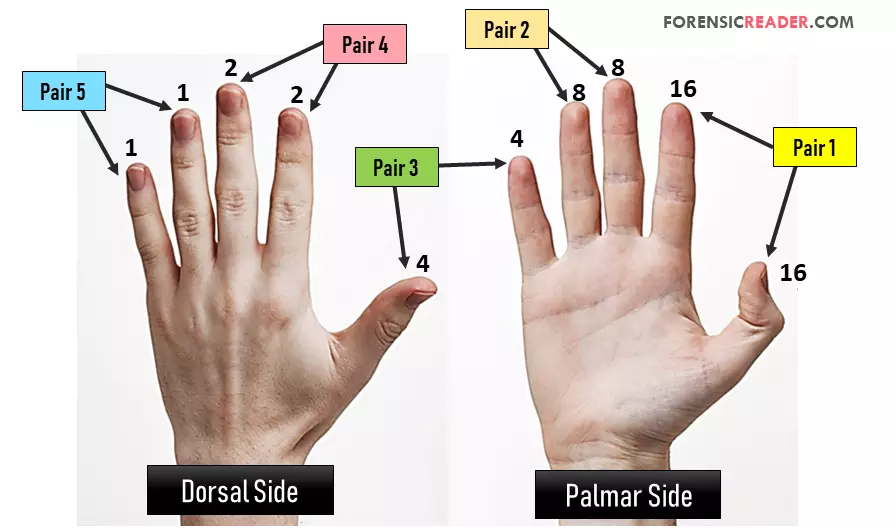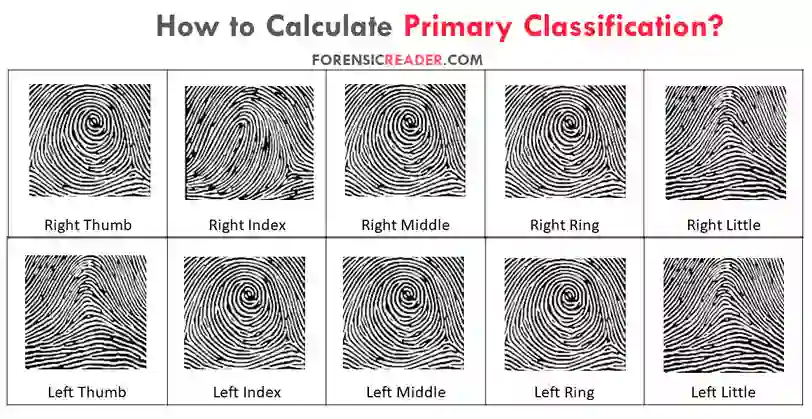Primary classification is the first division for classifying fingerprints using the Henry fingerprint system. It is also called whorl division because it uses only whorl patterns across all the fingers. Here, the values are calculated based on the summation of even and odd fingers, separately followed by the addition of one.
The above para is a short introduction to primary classification. Later, this article teaches you how to calculate primary division numbers, how groups are arranged, and a better way to learn primary whorl values.
At the end of the post, I also included three practice worksheets to help you grasp the topic more accurately.
Rules For Primary Classification System
- Classifying fingerprints always starts with the primary division
- Fingers included: All fingers
- Numerator: Sum of even fingers + 1
- Denominator: Sum of odd fingers +1
- Position in Henry number: rest in between major division and secondary division.
- Patterns: Only Whorls
- Values:
- Whorls: Specific assigned numbers for whorls (check how to remember, later in the post)
- Loops and Arches: Zero
- Possible groups: 1024 (210)
- Highest possible group value: 32/32
- Lowest possible group value: 1/1
Note 1: There are possible 1024 (210) groups. This is due to the fact that there may or may not be whorls on each finger. So, the value could be 0 or the specific numerical value for the ten digits.
Forensic Tools: Henry Classification Calculator for Primaries
-> Simple as click
-> No need to do calculations from your side
-> Unlimited number of attempts
Check Now: Henry Classification Calculator For Primary Division
How Groups Arranged in Primary Classification System By FBI?

The primary group’s value goes from 1/1 to 32/32.
- Starts with 1/1.
- For the first row, the denominator is ‘1’ and remains constant until the numerator goes from 1 to 32.
- Denominator moves to ‘2’ and numerator goes from 1 to 32.
- The process continues until the denominator reaches 32 and the numerator goes from 1 to the last group 32.
This is how primaries are arranged in groups that lead to 32×32 =1024 or 210 groups.
Note 2:The concept of even and odd number fingers as numerator and denominator (respectively) are used in Henry’s primary division. However, other division uses the right hand as the numerator and the left hand as the denominator.
Numerical Values for Primary Classification System
A. Numerical Values for Whorls
If the whorls appear in any of the fingers, the following specific assigned numerical values are assigned.
| Rt Thumb (1) 16 | Rt Index (2) 16 | Rt Middle(3) 8 | Rt Ring (4) 8 | Rt Little (5) 4 |
| Lt Thumb (6) 4 | Lt Index (7) 2 | Lt Middle (8) 2 | Lt Ring (9) 1 | Lt Little (10) 1 |
Note 3: The values shown above are not exclusive to the plain whorl. Any form of the whorl, such as a central pocket, double, or accident loop whorl, can share the same numerical value. This is because, in primary classification, ridge trace values are not determining factor but their appearance.
Finger Pairs in Primary Classification System
The above 10-digit fingerprints form five pairs, each of which has the same values.
| Pair Number | Finger Name | Primary Value |
| Pair 1 | Right Thumb & Index | 16 |
| Pair 2 | Right Middle & Ring | 8 |
| Pair 3 | Right Little & Left Thumb | 4 |
| Pair 4 | Left Index & Middle | 2 |
| Pair 5 | Left Ring & Little | 1 |
To master the above table, try this method.
- Place your right hand’s palmar side facing you.
- And your left hand’s dorsal area (back of the hand) facing you.
This is how it looks.

- Begin numbering from pair 1, i.e. the right thumb, with value 16, and move backward (towards the left hand).
- After two fingers, divide the previous value by 2 to get the new value. So, the value for RM and RR is 16/2= 8.
- Similarly, the RL and LT value is 8/2= 4.
- Lastly, LI and LM= 4/2= 2 and LR and LL= 2/2 =1
I hope this explanation helps you remember this particular number system for a long time. Let me know in the comments.
B. Numerical Values for Loops and Whorls
As previously stated, the value for loop and whorls is ‘0’.
But…What if all the fingers have loops and whorls?
Is the primary classification value is can be zero?
NO, absolutely not.
To overcome this problem of getting a 0/0 value, ‘1’ is added to both numerator and denominator. Therefore, the primary group value cannot be zero, and the lowest possible value would be 1/1.
Why ‘1’ is added to Both Numerator and denominator?
As stated earlier, to overcome the group value of 0/0 in the primary classification group, 1 is added.
But why 0/0 group would be a problem?
Because other classifications, such as major division and sub secondary classification, can have values O/O (alphabet), which is easily misunderstood with 0/0 (number). Moreover, specifically, major division values are right to primary which can create confusion.
So, this is the actual reason why 1 is added in both numerator and denominator.
How to Calculate Primary Classification Number?
Following is an example of a 10-digit card. Let’s use this to understand how you can easily calculate the primary classification number of fingerprints.

Step 1: Identifying Whorl Patterns
| Rt Thumb | Rt Index | Rt Middle | Rt Ring | Rt Little |
| W | W | W | ||
| Left Thumb | Left Index | Left Middle | Left Ring | Left Little |
| W | W | W |
Check our dedicated article on how to fill 10-digit cards and extract information from them.
Step 2: Assigning Whorl Values
As per the table, the following is the respective value.
| Rt Thumb | Rt Index | Rt Middle | Rt Ring | Rt Little |
| 16 | 0 | 8 | 8 | 0 |
| Left Thumb | Left Index | Left Middle | Left Ring | Left Little |
| 0 | 2 | 2 | 1 | 0 |
Step 3: Addition of Even/Odd Finger Value
- Numerator: Sum of even-numbered fingers such as 2, 4, 6, 8, and 10
- Denominator: Sum of odd-numbered fingers such as 1, 3, 5, 7, and 9
Note 3: You are not required to add the values using LCM. You just simply have to add the values of all numerators and their respective denominators.
- Numerator: Adding all the even fingers=> 0 + 8 + 0 + 2 + 0 = 10
- Denominator: Adding all odd fingers=> 16 + 8 + 0+ 2 + 1 = 27
Note 4: When dealing with a 10-digit card with lots of whorls, you can speed up the calculation process by subtracting the values of the non-whorled print. For example: if only the left little finger (finger #10, even) is a non-whorl finger, you can subtract ‘1’ from the highest possible no. 32 of the numerator. I know this might confuse you. Sorry for that. But this is how you can save some time.
Step 4: Adding ‘1’ to Them
After adding all, it comes to be 10/27. Now, as per the rule, add arbitrary 1 to both numerator and denominator.
- Numerator: 10 + 1= 11
- Denominator= 27 + 1= 28
Finally, the primary division number = 11/28
Primary Classification In Scarred and Amputated Fingers
While classifying prints such as scarred, amputated, or finger missing from birth, the following are two sets of rules are used.
A. Scarred Fingerprints
The following is an overview of how primary division values are obtained in the case of scarred fingerprints.
| Possible Rule for Primary Division Only | Primary Values |
|---|---|
| Rule 1: Fully Disfigured Impressions | Patterns form corresponding opposite hand |
| Rule 2: Partially Scarred With Possible Known Pattern type | Use the possible pattern type |
| Rule 3: Both Corresponding Opposite Finger are fully disfigured | Whorls pattern assigned |
B. Amputated Fingers
The following table is only valid for primary classification value determination for amputated fingers.
| Possible Rule for Primary Division Only | Primary Values |
|---|---|
| Rule 1: 1, 2, 3, or 4 Amputated Fingers | Patterns form corresponding opposite hand |
| Rule 2: Two Opposite Finger are Amputated | Both fingers are assigned as whorls |
| Rule 3: All fingers are Amputated | 32/32 values |
| Rule 4: Both Hands are Amputated | Footprints are used |
Note 5: Fingerprints from bandaged fingers are taken after they heal. But, if the healing can’t be possible or result in scars, the values are taken as scarred fingers.
The article guides you on how other classifications are obtained from scarred, bandaged, amputated, and fingers missing from birth. Check it: Classification of the fingerprint using scarred, amputated fingers (coming soon).
Primary Classification of Fingerprint Worksheet
Practice Worksheet #1

Step1: Identifying Whorl Patterns
| Rt Thumb | Rt Index | Rt Middle | Rt Ring | Rt Little |
| W | W | W | ||
| Left Thumb | Left Index | Left Middle | Left Ring | Left Little |
| W |
Step 2: Assigning Whorl Values
| Rt Thumb | Rt Index | Rt Middle | Rt Ring | Rt Little |
| 16 | 0 | 8 | 8 | 0 |
| Left Thumb | Left Index | Left Middle | Left Ring | Left Little |
| 0 | 0 | 0 | 0 | 1 |
Step 3: Addition of Even/Odd Finger Value
- Numerator: Sum of Even finger: 0+8+0+0+1=9
- Denominator: Sum of odd fingers: 16+8+0+0+0= 24
Step 4: Adding ‘1’
- Numerator: 9 + 1= 10
- Denominator= 24 + 1= 25
Finally, the primary group value = 10/25
Forensic Tools: Henry Classification Calculator for Primaries
-> Simple as click
-> No need to do calculations from your side
-> Unlimited number of attempts
Check Now: Henry Classification Calculator For Primary Division
Practice Worksheet #2
Following is the table with whorls at their respective position. All black spaces are either arches or loops.
| Rt Thumb | Rt Index | Rt Middle | Rt Ring | Rt Little |
| W | W | W | W | |
| Left Thumb | Left Index | Left Middle | Left Ring | Left Little |
| W |
Step 1: Assigning Whorl Values
| Rt Thumb | Rt Index | Rt Middle | Rt Ring | Rt Little |
| 16 | 16 | 0 | 8 | 4 |
| Left Thumb | Left Index | Left Middle | Left Ring | Left Little |
| 0 | 2 | 0 | 0 | 0 |
Step 2: Addition of Even/Odd Finger Value
- Numerator: Sum of even fingers= 16+8+0+0+0=24
- Denominator: Sum of odd fingers= 16+0+4+2+0= 22
Step 4: Adding ‘1’
- Numerator: 24 + 1= 25
- Denominator= 22 + 1= 23
Finally, the primary classification number = 25/23
Practice Worksheet #3: All are Whorls
Following is the table with whorls at their respective position.
| Rt Thumb | Rt Index | Rt Middle | Rt Ring | Rt Little |
| W | W | W | W | W |
| Left Thumb | Left Index | Left Middle | Left Ring | Left Little |
| W | W | W | W | W |
Step 1: Assigning Whorl Values
| Rt Thumb | Rt Index | Rt Middle | Rt Ring | Rt Little |
| 16 | 16 | 8 | 8 | 4 |
| Left Thumb | Left Index | Left Middle | Left Ring | Left Little |
| 4 | 2 | 2 | 1 | 1 |
Step 2: Addition of Even/Odd Finger Value
- Numerator: Sum of even fingers= 16+8+4+2+1=31
- Denominator: Sum of odd fingers= 16+8+4+2+1=31
Step 3: Adding ‘1’
- Numerator: 31 + 1= 32
- Denominator= 31 + 1= 32
Finally, the primary classification number = 32/32
Similarly, if all patterns of the fingerprint are loops or arches, the primary classification value will be 1/1.
Why Other Divisions Needed Too Other than Primary?

These are because of these three reasons:
1. Not all groups are quantitatively the same: Groups from 1/1 to 32/32 are not equitable distributed. As per the FBI, group 1/1 itself shares about 25% of total prints. So, these types of groups are further needed to be subclassified for smaller searching groups.
2. Too big to Seach: Let’s say, only if primary classification is used across the whole population. For every 1M population, there is an average of 3000 prints. And if it is a group with fewer whorls (like 1/1, no whorls), the number of prints to compare would be in lakhs.
That many prints consume a lot of resources and time. So, with the addition of subdivisions, the primaries are further grouped down into smaller searched groups for more easy and more convenient identification.
3. Reverse Engineering: One can’t possibly state the type of prints does finger has using primary numerical values, not even whorls (can be central pocket or double loop whorl). This is also true for the other type of prints such as arches and loops. Furthermore, it is devastating if the finger is later amputated or scared off.
Frequently Asked Questions
What is the fingers represent the numerator in the primary division?
Right Index (finger #2), Right Ring (finger #4), Left thumb (finger #6), Left middle (finger #8), and Left little (finger #10) are placed in numerator. In other words, all even fingers on 10 digit cards are used as numerator while all odd-numbered finger is used as the denominator in the primary classification of fingerprints.
What is the numerical value of the primary classification if five fingers of the right hand are loops while five fingers from the left hand are arches?
The value would be 1/1. Here, all ten fingers are either loops and arches whose value is zero. So, their addition will give 0/0. Later, as per the classification rule, 1 is added to both numerator and denominator, resulting in the value of 1/1.
What are the patterns used to obtain the primary classification?
Whorl patterns are only used to obtain primary classification numbers. That’s why this division is also called the Whorl division.
What values are assigned to fingers of 3rd pair in primary classification?
The numerical value for the 3rd pair (Right little and Left thumb) in primary classification is value ‘4’.For the 4th pair, the value is ‘2’. For the 5th pair, the value is ‘1’. And for the 2nd pair, the value is 8. Lastly, for 1st pair, the value is 16.
Forensic Tools: Henry Classification Calculator for Primaries
On easy clicks with unlimited attempts.
-> Try Now: Henry Classification Calculator For Primary Division
Also Read:
- Secondary Classification of Fingerprints With Small Letter Grouping
- Final Classification of Fingerprint: Rules, Worksheet, and Amputated Fingers
- Direct Transfer Method of Latent Fingerprint Development With Procedure

FR Author Group at ForensicReader is a team of Forensic experts and scholars having B.Sc, M.Sc, or Doctorate( Ph.D.) degrees in Forensic Science. We published on topics on fingerprints, questioned documents, forensic medicine, toxicology, physical evidence, and related case studies. Know More.
